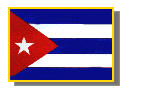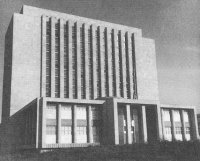

|



 Cuba
Cuba

|
Directory Information
|
In 1901, by a military order during the United States occupation of Cuba, a director to the National Library was appointed. In1936 a Cuban writer and historian, Emilio Roig de Leuchsenring, who was Historian of the City of Havana, denounced the poor condition of the National Library through his articles in the weekly magazine Carteles and called urgently for improvement. TheAsociaci6n de Amigos de la Biblioteca Nacional(Association of Friends of the National Library) was founded. Many distinguished writers and historians were members, with Emilio Roig de Leuchsenring as President.
In 1935 the Foreign National Association, based in New York, published a report entitled "Problems of the New Cuba," which cited the National Library's11 shameful conditions. Its shelves were drawn off during the President Machado administration and the books were packed into boxes and stored in a facility belonging to a state prison, and even though they have already been returned to the library, the deplorable state of the building and the shelves made possible the unpacking [of only] a few volumes; in addition a fire took place in the building and a great deal of books were burned to ashes."
In 1938 the government decided to move the Library to the Castillo de la Fuerza and to tear down the building that housed it and build a police station instead. The books were packed again with haste and transferred to their new place.
The lack of resources and qualified personnel led to deteriorating conditions that became so obvious that the government appointed a Cuban writer and diplomat, Joss Antonio Ramos, as the library technical adviser, giving him power over cataloguing and classification. Ramos implemented a system of classification on his own, based on the Universal Decimal System and adapted to Cuban needs. His was undoubtedly the most significant attempt to organize the bibliographic resources of the institution up to that time. After struggling to improve the National Library, Ramos resigned in 1946, shortly before his death.
In 1941 the government imposed a one-half cent tax on each 325-pound sugar bag in order to raise funds to build a National Library. Construction of the National Library's new building began in 1952. It was named after Jose Marti (1853-95), the Cuban national hero who was a poet, a thinker, a warrior, and a "symbol of the National Liberation against colonial-ism and imperialism."
After the Cuban Revolution of 1959, sweeping changes took place in the Library as well as in the rest of the country. Maria Teresa Freyre de Andrade,Cuban librarian and long a fighter for the development of librarianship in Cuba, was appointed Director of the institution. She started intense efforts to move the National Library toward modern goals and to make libraries reach everyone. She also encouraged there form of library science studies at both university and technical levels.
The government resolved that all books that belonged to dictator Fulgencio Batista (1901-73), to his associates, and to people leaving the country should be transferred to the National Library. These "rescued libraries" played an important role in filling out the collections of the National Library and in starting collections in the new libraries in various parts of the country.
Because of the shortage of libraries, the National Library has served as a public library. Its Department of Bibliographic Research created a Union Catalogue of Scientific and Technological Periodicals and a Union Catalogue of Social Sciences and Humanities. A special service of the National Library is the Children and Young Adult Department. Its activities, including storytelling, painting, literature, philately, and others, have been the model for other children's and juvenile libraries in the country. At the international level, the National Library has an information exchange agreement with the Centro de Informacien Cientifica Tecnica Humanistica (CICH) of the Universidad Nacional Autenoma de Mexico. It coordinates the cultural information exchange work of several cultural institutions in Cuba. In 1989, as part of a restructuring of the Ministry of Culture, the Biblioteca Nacional Joss Marti became the National Methodological Center for the Public Library Network, head of a network for culture and arts information with as its main objective the present and prospective condition of public libraries in the country.
It became responsible for promoting reading among adults and children through the Programa Nacional de la Lectura. It also assumed responsibility for collecting the official documents of the Ministry of Culture into the Archivo General de Cultura and for organizing the Biblioteca Memorial Juan Marinello, honoring a Cuban leader who bequeathed his library to the National Library National Bibliography.
In the 19th century the Cuban scholar Antonio Bachiller y Montes published his Apuntes para la Historia de las Letras y la Instruccien Publica en Cuba. The second volume of that work includes the first account of periodicals edited in Cuba; the third makes the most important contribution to the field of bibliography of that time. It was titled Catalogo de Libros y Folletos Publicados en Cuba desde la Introduccion de la Imprenta hasta 1840.Some Cuban and foreign authors worked to compile the national bibliography during the first half of the 20th century. Carlos M. Trelles was the most important of the group, because of the completeness and accuracy of his Bibliogra Cubana del Sigio XX, published in 1917. From 1937 to 1958 the Anuario Bibliografico Cubano, compiled and edited by Ferrnin Peraza, tried to continue the work of Trelles. In 1959 the National Library was appointed to compile and publish the Cuban National Bibliography. It published the bibliographies for the following years: 1917 to 1920 (published 1960); 1921 to 1936(1979); 1959 to 1962 (1968); 1963 and 1964 (1967); and yearly from 1965.
National Archives. The Archivo General de la Isla de Cuba was founded by an order of the Queen of Spain in 1840. In 1888 the Captain General of the Island, by. order of the Madrid government, sent to Spain 2,300 documents of great historical value. An official decree of December 20, 1904, established the island institution as the National Archives.
From 1921 to 1956 an outstanding Cuban historian, Joaquin Liaverias y Martinez, was its Director. He had "a constant preoccupation [with] the search forand conservation of valuable documents that are in the collection of the institution." From 1945 to 1958 it published the periodical Metnorias. In 1963 the National Archives was attached to the Academia de Ciencias de Cuba. It succeeded in forming a network of provincial and regional archives.
f.1901; Marta Terry Gonzalez;
1 mo vols: 28285 mss; 17 incunabula;
14075 music scores; 9518 maps;
76598 av-mst;
libr loan 08727
Sources:



|